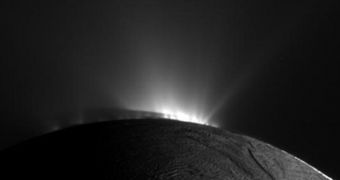The NASA Cassini spacecraft has just sent back new image and datasets of the Saturnine moon Enceladus, which it visited during a close flyby on November 30. The photos alone are amazing, showing the geysers at the moon's south pole in great detail.
During the flyby, the orbiter swooshed about 48 kilometers (30 miles) above the surface of the planet, snapping pictures as it went along. The main target of the new flight was the northern hemisphere.
However, the space probe was also able to capture some images of the most astounding features on the object, the tiger stripe-like structures and the active geysers in the southern hemisphere.
These geysers are tremendously interesting to science, largely because they spew out jets of water-ice vapors and organic molecules. Some believe that the jets themselves are powered by the motions of an underground ocean made of liquid water.
Ever since this idea was proposed, scientists operating Cassini have been attempting to collect sufficient data to either confirm or infirm the hypothesis.
The hope is that large enough datasets could allow experts to derive a satisfying answer the international astronomical community can agree upon.
What's interesting about the new images showing the geysers is that they were taken with the Sun behind Enceladus, as seen from Cassini. This means that the jets were back-lit, providing an awesome view for the orbiter's cameras.
According to experts at the NASA Jet Propulsion Laboratory (JPL), in Pasadena, California, who manage the mission for the agency's Science Mission Directorate in Washington DC, this is the 12th flyby Cassini did of Enceladus.
During the November 30 flyby, the radio instrument suite aboard the spacecraft was used to collect precise gravitational measurements of the moon.
Experts hope to use them to determine how the interior of Enceladus looks like. Leaning how matter is distributed within could be the key towards unraveling whether a liquid ocean is actually there, and whether it is responsible for producing the jets.
Enceladus and Titan are the most interesting moons of Saturn, as far as astronomers see things. Why the former is interesting is mentioned above. On Titan, things are somewhat different.
The moon, Saturn's largest, features lakes of liquid hydrocarbons (methane and ethane) on both its poles, and recent studies have demonstrated that the chemistry needed to underlie life may take place in its atmosphere without the need for external stimuli.

 14 DAY TRIAL //
14 DAY TRIAL //